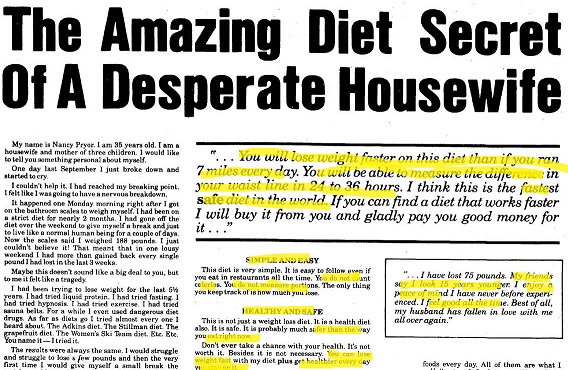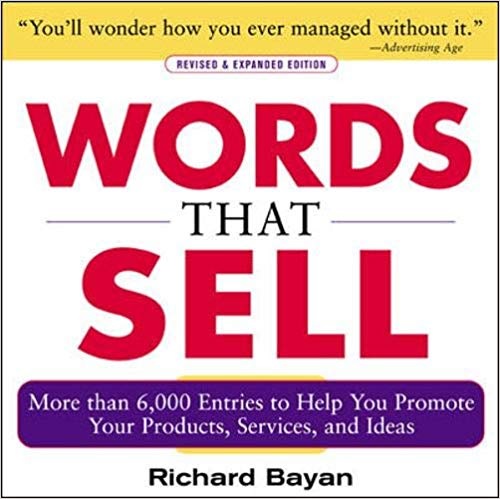Ugh…
I remember my very first copywriting effort.
There were enough articles and posts online proclaiming you could make money writing copy that I decided to give it a shot. What the heck, I wrote enough papers in college that professors liked my stuff so why not?
I mean, what could possibly go wrong?
S0 I grabbed a random product idea and started writing about it as if I were trying to sell it to my mother. I think it was an ad about a fishing lure or something like that…
After finishing, I went to an entrepreneur site called The Warriors Forum (WF).
The WF has a section in it where all the cool, experienced copywriters hang out.
(Do you remember when you were in junior high and wanted to be in with the “cool kids” and you’d just about pee your pants with delight if one of them even glanced at you? That’s what I felt like with these guys.)
I posted my awe-inspiring copy and asked them if they wouldn’t mind taking a look at it when they had the chance. I even said, “Thank you in advance” or some dumb ass thing like that hoping it would please them a little.
To cut a long story short, they ripped me a new butt-hole.
They even bashed the very first word I wrote.
That’s right, the very first word!
I remember thinking, “Maybe scrubbing toilets in Grand Central Station wouldn’t be such a bad career after all.”
Yeah, they were brutal on me, but it was exactly what I needed to hear. Considering that these were busy entrepreneurs, they were actually being nice to me and their critiques were spot on.
Not only that, one of them decided to mentor me for free and I will be forever in his debt.
In this post, I’m going to reveal a copywriting secret that will show you exactly where I went wrong and how you can quickly learn to write copy that’ll get eyes on your pages. If you’re new to writing copy, this is a pretty important lesson. If you’ve been writing for a while, then you can take this opportunity to go back over the basics.
Either way, once you’re done reading this you’ll be forever in MY debt. (Ha-ha…Just kidding.)
Two Factors You Don’t Want to Confuse
We are now coming to the part where you’re going to start writing the body of your copy. When you were writing your deck copy (the headline, pre-head, and subhead) you were trying your best to get the attention of your readers and prospects.
This is where we’ll kick things into high gear and really start selling with our words.
What’s the best way to do that? By showing clear advantages and benefits of what you have to offer.
Let’s pretend for a second that you’re selling a car. Your customer comes into the showroom floor and you launch into your pitch.
“This is the 2020 Bentallac. It has leather seats, drink cup holders, and has been painted in a royal blue color.”
Now let’s try your pitch from a different angle. This time your prospect comes into the showroom and you start pitching like this:
“This is the 2020 Bentallac. It has been designed with your family in mind. It seats 7 people comfortably so you can go on vacation with your entire family without feeling cramped or crowded. This lovely vehicle also comes with vital safety features like spring-loaded seat belts which prevent back injuries in the case of a sudden stop…”
In the first pitch, you talked about these factors:
- Leather seats
- Cup holders
- Color of the car
In the second pitch, you told them about…
- It’s designed for families
- You can fit 7 people in it and you won’t be cramped
- Seat belts are built for safety and to reduce injury
The 2 factors involved here are features and benefits and it’s important you understand the difference between the two of them.
[ctt template=”1″ link=”dfU_1″ via=”no” ]The 2 important factors in writing copy are features and benefits and it’s important you understand the difference between the two of them.[/ctt]
Features and Benefits: Important for Writing Compelling Copy
Features are descriptive items like:
- Color
- Gadgets
- Texture of Seats
- Smell
- Transmission
- Engine Power
Benefits tell your prospect what the product will do for them.
- Keep your family safe
- Comfortable space even when fully loaded
- Good for taking long trips with family
It’s important to note that sometimes the line between features and benefits can become blurred. For example, the color can become an important benefit to some people.
I live in a state where the color blue is ultra-important to the people and their culture who live here. Telling a customer that they can proudly drive a car that displays their local pride is a big deal.
So, you can sometimes turn a feature into a benefit. (Color = Loyalty to culture displaying local pride.)
The real copywriting secret behind this is knowing how to seamlessly use features and benefits in your copy; keep reading if you want to learn how.
Why Both Parts are Important
When you’re selling something, both the features and the benefits are important.
The benefits will awaken the desire in your reader while the features will give you working knowledge of how your product or service works.
The main thing you must keep in mind when writing copy that sells is that it must show the reader what’s in it for them. In other words, how will your product or service fix a problem, make their life easier, or enhance their quality of life in some way?
Copywriting Secret: Increase and Fear — Two Ways to Motivate Your Reader
There are two ways of stimulating desire in your reader. You can show them how their lives will be made better in some way, or you can scare the crap out of them using fear tactics.
Here’s an example of what I mean.
Years ago, I got some direct mail pieces from a famous marketer who was advertising his information product seminar.
One of the pieces told me how I could make bazillions of dollars by creating and then selling my own information products.
The headline of the sales letter said something like this:
“Get in on the Next Economic Boom by Creating and Selling Information Products People are Dying to Buy…”
Basically, the copy in the sales letter talked about how fast and easy it was to get in on making your own info products. It also detailed how you could make a pant load of money with low risk doing so.
The other piece that I got in the mail said (from the same guy, I might add):
“You Better Cash in Now on Creating and Selling Your Own Information Products Because There’s an Economic Crap-Storm Coming!”
Both of these letters were pushing the same seminar but just used two different, yet effective angles to promote it.
One used the element of opportunity/increase while the other one used fear.
On the increase side, you can show people how they can gain, save or accomplish with your service or product.
INCREASE SIDE
- Mental
- Physical
- Financial
- Emotional
- Social
- Security
- Health
FEAR SIDE
- Loss
- Scarcity
- Accidents
- Poverty
- Embarrassment
- Drudgery
- Doubts
- Illness
- Accidents
The main reason why the Increase and Fear factors are so important is that your prospect’s desire must be aroused before you try to sell them on what your product can do for them.
I remember years ago, I lived in Germany and there was a Mercedes car dealership just down the street where I lived. On any given day, I would walk past the lot where there was a salesman who would launch into a memorized list of every feature of just about every car on the lot.
I would hear him say, “This is a Mercedes 2390 with a 200 horsepower engine…”
And he would ramble on about the types of seats, tires, etc. flawlessly.
Being young and inexperienced in business, I thought his presentation was amazing and the way he could spit out all of those facts and figures blew me away.
However, now that I’ve been around the block in the world of sales, I can see a major flaw in his approach.
He did not know WHY people were coming on the lot to look at cars. And because he didn’t know WHY they were looking at those cars, he did not know WHAT they were looking for. So, he was probably wasting his breath on all of those facts and features.
He had no clue as to the real desire of the prospects he had coming on to his lot. He would have probably fared better if he had asked them a few probing questions, like:
“Are you looking for a family vehicle or a smaller sports car?”
“Will you be using this vehicle for commuting to work or are you going to be driving on long-distance trips?”
You know, stuff like that.
The bottom line is, the more you know about what your readers want and need the easier it will be to arouse their desire and make the sales process easier.
How to Become Sensitive to What Your Market Wants
In order to create a desire in your prospects, you’ll need to find out what makes them tick.
One of the things you’ll hear copywriting experts talk about is becoming an expert in a niche.
That’s because you can’t be “Everyman”. Everyman is a superhero who knows everything about everyone.
The problem with Everyman is that he is 100% fictitious. Everyman only exists in your mind.
You need to become “Specialistman” (or “Specialistwoman” if you so desire). This is a superhero that focuses on a niche or a particular segment of the market.
Why is narrowing down your focus so important?
Because if you specialize in a specific segment of the market, it will make life so much easier for you as a copywriter.
For example, if you’re writing copy for businesses in the financial market, you’ll only need to gain knowledge in that arena.
Also, you’ll probably narrow down which aspects of the financial market you want to specialize in, like stock trading. It will eliminate the need to research all of the other types of investments there are if you pick one niche to work in.
So step one in becoming a great copywriter is…pick a niche.
Copywriting Secret: Start Collecting this Stuff
The next step in becoming a copywriter is to read as much as you can about your chosen field.
Look for or collect:
- The best websites your niche has online
- The best online forums in your niche
- Bestselling books to read on the subject
- Online videos by experts in the field
- TV shows that are dedicated to your subject
- Direct mail pieces sent to your home from people selling the kinds of stuff in your niche
- Magazine ads that are in your niche
In other words, you’ll want to totally immerse yourself into the market you want to operate in.
Once you’ve collected some of this material, you can start organizing it into a thing called a swipe file. A swipe file is a file that you can draw ideas from.
If you’re going to write ads, articles, or anything else in a particular market, you’ll need to file them together. You will create different categories of swipe files for different niches.
(Of course, you can have more than one niche, most copywriters have at least three or four they will write for over their careers, but when you’re first starting out, you’ll want to specialize in just one or two.)
Copywriting Secret: How to Use a Swipe File to Ignite Desire
Once you’ve collected at least 10 to 20 swipes in your niche, you can then begin to dissect them.
Let’s say you have to write a landing page for a diet website. You can take your swipe files from that niche and dissect them. Just take a highlighter pen and highlight all of the benefits you can find in your copy.
I know what you’re thinking. You’re thinking, “Gee, aren’t there a million different diet plans?”
Yes, there are. However, the benefits are almost always the same.
- Improved health
- Better intimacy
- Looking slim and sexy
- Weighing less
- Ability to do more
In the fear department:
- Rejection by others
- Loss of a job
- Tight and uncomfortable clothing
- Death or health-related issues
- Higher insurance costs
When you’re using your highlighter, make sure you mark phrases that are expressing these benefits and fears.
Once you’ve highlighted them you can then type them into a word processor as a databank to use while writing your copy.
Note: Incidentally there are two excellent books you should get as a resource for this.
They are written by the same man and they are titled, “Words That Sell” and “More Words That Sell” by Richard Bayan. He has compiled loads of phrases and words he has gathered from his own swipe files and has categorized them by different niches and by different situations.
These books will make your life so much easier for getting ideas and reduces the amount of time you’ll spend digging up ideas from swipe files. (I’d still do the research on the front end with at least 10 swipes.)
The First Things You Say Are the Most Important
In my last post, I showed you how to attract attention using the AIDA Template. I told you how important it is to make sure you nail your headline because it will lead readers into your copy.
However, your very first paragraph is extremely important as well. You’ve gotten their attention with the headline, now you’ve got to bring them into your copy.
You can write the greatest headline in the history of the world, but if your first paragraph sucks, your readers will leave. Here are a few ways to keep your reader on the page while igniting his desire to read on.
Keep Going – You want to continue on with the idea(s) you used in your headline. However, you don’t want to tell them everything, just enough to whet their appetite.
Don’t Ramble – Keep your sentences short and to the point. You don’t want to bore your audience with a bunch of facts and figures. You want to move them into the next paragraphs smoothly.
Give Them Something – You used a great headline to get your readers to look at your ad, or blog post, now you’ve got to start fulfilling your promise without revealing everything.
Use Bold Statements or Questions – If you can use a question to make your reader think, so much the better. This gets engages their brains so that they will relate to your copy better. Also, if you can make a bold or controversial statement it will engage their emotions as well.
Conclusion
I seem to have rambled on quite a bit about this and added more than one copywriting secret. Actually, they aren’t really secrets but techniques that copywriters have been using for ages. (Whenever I buy a copywriting course, the writers usually refer to them as copywriting secrets…So, what the heck.)
But the bottom line is writing engaging copy that ignites a reader’s desires is extremely important in crafting copy and writing blog posts as well.
Copywriting Secret: A good idea when writing an ad is to find successful copy which is similar to what you want to write and practice writing it out several times. That way you’ll get a good feel for phrases, sentences and other ideas that you can infuse into your copy.
Personal Note: There are 3 affiliate links on this page. I do not get rich promoting this stuff, but it does pay for my coffee.




